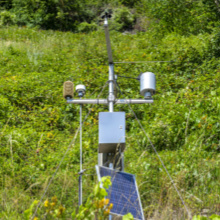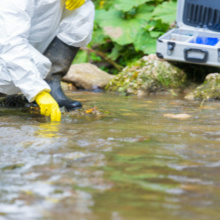In today's rapidly changing environment, monitoring air and water quality has become more important than ever. Whether it's ensuring clean air in our homes, workplaces, or understanding pollution levels outdoors, reliable environmental monitoring is essential for safeguarding public health and the planet. Our advanced monitoring solutions are designed to provide accurate and real-time data for atmospheric, indoor air quality, pollution source, and water quality monitoring. With cutting-edge sensor technology, we help industries, regulatory bodies, and individuals make informed decisions to maintain a safe and healthy environment.


Atmospheric Monitoring

Indoor Air Quality Monitoring

Pollution Source Monitoring

Water Quality Monitoring
Atmospheric Monitoring
Atmospheric monitoring involves tracking and analyzing the quality of air in outdoor environments to understand pollution levels, weather patterns, and climate changes. This process helps identify pollutants such as particulate matter (PM2.5 and PM10), sulfur dioxide (SO₂), nitrogen oxides (NOx), ozone (O₃), and carbon monoxide (CO). Regular atmospheric monitoring is crucial for urban planning, environmental policy, and ensuring public health.
- Key Applications: Weather forecasting, air pollution studies, public health assessment, compliance with environmental regulations.
- Common Sensors Used: PM2.5/PM10 sensors, CO sensors, NOx sensors, O₃ sensors, and SO₂ sensors.
| Image | Model | Title | Target | Detection range | Output |
|---|---|---|---|---|---|
 |
ZEHS04 | Atmospheric Monitoring Sensor Module | CO, SO₂, NO₂, O₃ (Scalable PM2.5, PM10, Temperature, Humidity) | / | UART, RS485 |
 |
ZE12A | Electrochemical Detection Module | CO, SO₂, NO₂, O₃ | CO (0-10ppm), SO₂ (0-1ppm), NO₂ (0-1ppm), O₃ (0-1ppm) | DAC, UART |
 |
ZCE04B | 4-in-1 Industrial Gas Detection Module | CH₄, CO, H₂S, O₂ | 0-100%LEL, 0-1000ppm, 0-100ppm, 0-30%LEL | UART |
 |
4R-PID | Photoionization PID Sensor | VOC | 0-10000 ppm | / |
 |
ZI01 | PID sensor module | VOCs | 0-2000 ppm | UART |
Indoor Air Quality Monitoring
Indoor air quality (IAQ) monitoring focuses on measuring the concentration of pollutants inside buildings, such as homes, offices, factories, and public spaces. Monitoring IAQ is vital for maintaining a healthy indoor environment, as poor air quality can lead to health issues like allergies, respiratory problems, and headaches. Key pollutants include carbon dioxide (CO₂), volatile organic compounds (VOCs), humidity, temperature, dust particles, and formaldehyde (HCHO).
- Key Applications: Ensuring healthy workspaces, maintaining indoor comfort, HVAC system optimization, and preventing Sick Building Syndrome (SBS).
- Common Sensors Used: CO₂ sensors, VOC sensors, temperature and humidity sensors, PM2.5 sensors, and formaldehyde sensors.
| Image | Model | Title | Target | Detection range | Output |
|---|---|---|---|---|---|
 |
ZP07 | Ten-level Air-Quality Detection Module | Air-Quality, VOC | / | 0-3 grade pollution signal |
 |
ZM106 | Small size, Low Power MEMS VOC Gas Sensor | Air-Quality, VOC | 0~10mg/m³ | UART |
 |
MH-Z1911A | NDIR CO₂ Module | CO₂ | 400-10000ppm(optional) | UART/PWM |
 |
PAS CO₂ | Photoacoustic PAS Carbon Dioxide CO₂ Sensor | CO₂ | 0-32000ppm(optional) | UART |
 |
WHT20 | MEMS type Temperature and Humidity Sensor | Temperature and humidity | / | / |
 |
ZH07 | High Performance Laser Dust Sensor | PM1.0, PM2.5, PM4.25, PM10 | 0-1000μg/m³ | UART/PWM |
 |
ZPH04 | Particles Sensor | PM2.5 | / | UART/PWM |
 |
ZE08-CH₂O | Electrochemical HCHO Sensor Module | CH₂O | 0-5ppm | UART |
 |
ZPHS01C | Multi-in-One Sensor Module | CO₂, PM2.5, CH₂O, VOC, Temperature, Humidity | / | UART |
 |
ZH10-VHT | Compact 4-in-1 Air Quality Sensor Module | PM2.5, VOC, Temperature, Humidity | / | UART/PWM |
Pollution Source Monitoring
Pollution source monitoring focuses on identifying and measuring pollutants emitted directly from industrial processes, transportation, power generation, and waste disposal. This type of monitoring helps industries comply with environmental regulations, reduces environmental impact, and ensures that emission levels remain within permissible limits. Common pollutants include greenhouse gases (GHGs) like CO₂, methane (CH₄), NOx, sulfur oxides (SOx), and particulate matter.
- Key Applications: Industrial emission control, regulatory compliance, identifying pollution hotspots, and optimizing emission-reduction strategies.
- Common Sensors Used: Gas analyzers for CO₂, CH₄, NOx, and SOx, particulate matter sensors, and continuous emission monitoring systems (CEMS).
| Image | Model | Title | Target | Detection range | Resolution |
|---|---|---|---|---|---|
 |
ZE80 series | Malodorous Gases Odor Sensor Module | Stench, odor, C8H8, CS2, C2H6S2, C2H6S, CH4S, H2S, C3H9N, NH3 | / | / |
 |
ME3-NH3 | NH3 Gas Sensor | NH3 | 0-100ppm, Max 200ppm | 0.5 ppm |
 |
ME3-H2S | Hydrogen Sulfide Gas Sensor | H2S | 0-100ppm, Max 500ppm | 0.1 ppm |
 |
ME3-CH4S | Electrochemical Gas sensor | CH4S | 0-100ppm, Max 200ppm | 0.1 ppm |
 |
ME3-C2H6S | Electrochemical Gas Sensor | C2H6S | 0-100ppm, Max 200ppm | 0.1 ppm |
 |
ME3-C2H6S2 | Electrochemical Gas Sensor | C2H6S2 | 0-100ppm, Max 200ppm | 0.1 ppm |
 |
ME3-C3H9N | Electrochemical Gas Sensor | C3H9N | 0-100ppm, Max 200ppm | 1 ppm |
 |
ME4-CO-E4 | Carbon Monoxide Gas Sensor | CO | 0-1000ppm, Max 2000ppm | < 10 ppb |
 |
ME4-NO2 | Nitrogen Dioxide Gas Sensor | NO2 | 0-20ppm, Max 150ppm | 0.1 ppm |
 |
ME4-SO2 | Sulfur Dioxide Gas Sensor | SO2 | 0-20ppm, Max 200ppm | 0.1 ppm |
Water Quality Monitoring
Water quality monitoring involves assessing the physical, chemical, and biological characteristics of water in rivers, lakes, oceans, and drinking water sources. It is essential for ensuring safe drinking water, protecting ecosystems, and complying with environmental standards. Key parameters include pH, turbidity, dissolved oxygen (DO), chemical oxygen demand (COD), biological oxygen demand (BOD), and levels of heavy metals like lead, mercury, and arsenic.
- Key Applications: Drinking water safety, wastewater treatment, aquatic ecosystem protection, and regulatory compliance.
- Common Sensors Used: pH sensors, turbidity sensors, dissolved oxygen sensors, conductivity sensors, heavy metal analyzers, and temperature sensors.
| Image | Model | Title | Output | Detection range | Resolution |
|---|---|---|---|---|---|
 |
ZW-NH101 | Ammonia & Nitrogen Detection Module | RS485 | 0~1000 mg/L | 0.1 mg/L |
 |
ZW03 | pH water quality sensor module | RS485 | / | / |
 |
MW-ORP101 | ORP water quality detection sensor | / | -2000 mV ~﹢2000 mV | 1 mV |
 |
MW-TDS101 | TDS Water Quality Sensor | / | 0-2000ppm | ±5% F.S. |
 |
MW-RCl101 | Residual chlorine water quality sensor | / | 0~20 mg/L | ±0.01 mg/L |
 |
MW-O101 | Dissolved oxygen water quality detection sensor | 0.93 μA -1.33 μA | 0~20 mg/L | ≤ ±0.10 mg/L |
- 0086-371-67169097
- sales@winsensor.com
- Mon - Fri 9am - 6pm
ARE YOU LOOKING FOR SENSOR
Not sure which sensor is right?
Get a free initial consultation right now